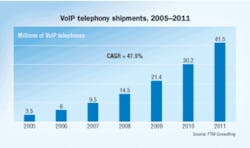The installation of LANs in the 1990s was the primary reason for the enormous growth in the structured cabling systems (SCS) market, especially unshielded twisted-pair (UTP) cabling-primarily Category 5-needed for the horizontal cabling subsystems. I reported years ago that this market saturated in the late 1990s, causing the SCS market to falter. Since then, cabling suppliers have tried to find alternate large markets for their SCS offerings. FTM Consulting recently analyzed the VoIP market and has concluded that a large, new market will be provided for SCS, specifically for UTP cabling.
The Internet created a whole new way of communication, no longer limited by the ancient public switched telephone network (PSTN). Internet Protocol (IP) provided the unifying means for universal connectivity. Initially, this spurred data communications among personal computers (PCs), and is now being expanded to other information content, such as video and voice. Digital security video cameras are now using IP in their own Ethernet subnetwork, connecting to larger data networks. Our recent analysis of the video cabling market indicated this application will provide a robust market growth for UTP cabling.
Our recent analysis of the VoIP market also indicates it is another IP subnetwork that can be integrated with the existing network. In our analysis, this niche VoIP market provides an opportunity as large as the previous data-networking market. Unlike the narrow video-cabling market niche, VoIP is a universally large market. Our analysis indicates that, four years from now, the UTP cabling market for VoIP applications will exceed the data-networking market for the first time. In five years, it will account for the majority of new UTP cabling deployments.
According to FTM Consulting, the 47.5% compound annual growth rate in VoIP telephone shipments between 2005 and 2011 will prompt a boost in enterprise recabling due to current telephone cabling system�s inability to handle VoIP transmission.
VoIP technology digitizes voice signals and sends them over the Internet in packets, just as data is transmitted over the Internet in data packets. VoIP is attractive because of the cost savings associated with using the Internet instead of the PSTN for voice transmission. After a number of false starts over the past several years, VoIP appears poised to grow rapidly as an alternate to the current telephone network. Early issues with VoIP, including reliability, QoS, and security have, for the most part, been overcome, making the services attractive to businesses and households.
VoIP requires that the analog voice signals be digitized and compressed; both of these functions are handled by specialized VoIP telephone sets or, alternately, PCs equipped with handsets and specialized software. The VoIP signals can be transmitted over the Internet directly or can access specialized VoIP carrier services now offered by most of the larger telephone companies.
Inside the premises, the signals from the VoIP telephones are connected to an Ethernet network in similar fashion to PC connections. We have identified three basic cabling architectures: IP private branch exchange (PBX) installations; single-line, non-IP PBX, in which a single horizontal cable supports both the PC data and the VoIP voice services; and dual-line, non-IP PBX, in which separate horizontal cables are used for the VoIP telephones and the PCs. In all three configurations, the structured cabling system is shared for supporting the data and the VoIP transmissions. This includes, for example, the riser cabling subsystems and routers.
The size and forecast for the VoIP cabling market are directly related to the number of VoIP telephones. Our analysis indicates an expected rapid growth in VoIP telephones. Starting from 6 million VoIP telephones this year, the market is expected to grow to 41.5 million VoIP telephones by 2011.
Our analysis indicates the market for VoIP cabling systems is forecast to grow from $499.1 million this year to $4.9 billion in 2011-an average annual growth rate of 57.9%.
One of the largest opportunities for structured cabling system suppliers in the VoIP market is in horizontal UTP cable. We expect that UTP cable for VoIP applications will account for 88.9% of the total UTP cable market by 2011.
FRANK MURAWSKI is president of FTM Consulting Inc. (www.ftmconsultinginc.com), which provides market forecasts and analysis of cabling-market trends.

